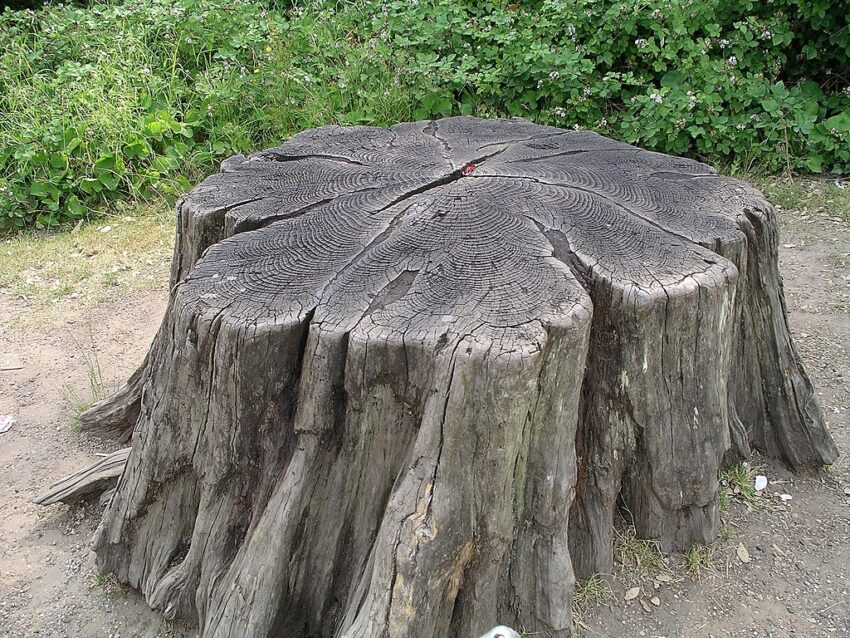Did you ever wonder about the origin of the word “stumped”? You probably understand where the term originated if you’ve ever tried to figure out how to remove a tree stump from your yard.
While there are many ways to remove a tree stump, all of them can be described as challenging. However, with the right tools and knowledge, you can successfully remove a tree stump from your yard without calling the pros.
How To Get Rid of Tree Stumps
On their own, tree stumps can take up to a decade or more to decay. During that time, tree stumps are an eyesore, make lawn care difficult, attract pests and diseases, and can have annoying root sprouts.
If you’re ready to start planting grass where that old tree stump is, you can choose from several DIY removal methods, including using chemicals, digging, grinding, and burning them. Always use safety gear when running dangerous equipment like chainsaws and stump grinders, and don’t forget to contact utility companies before you dig.
How To Kill a Tree Stump
Many deciduous trees will continue trying to grow even after they are cut down. So not only do you have to mow around an unsightly tree stump, but you also have to keep pruning the sucker shoots.
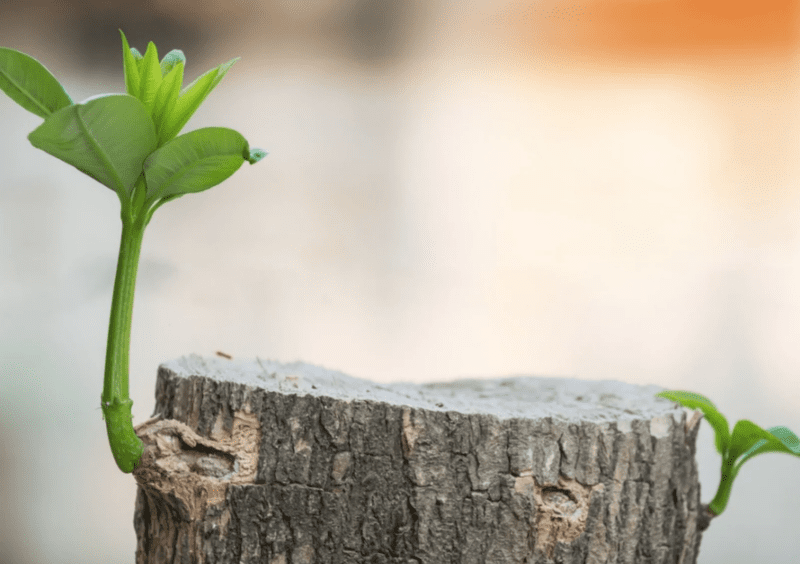
You can kill a tree stump using chemicals, and it will accelerate decay to make removal easier. This method takes longer than other ways to remove a stump, but it is one of the easiest, and you won’t have to keep dealing with irritating root sprouts.
Tools Required
- Chainsaw
- Electric drill
- 1” spade bit and 12” extension bit
- Ax
- Safety glasses
- Work gloves
- Tarp
Materials Required
- Stump remover chemicals
- Epsom salt
- Rock salt
- Water
- Soil
- Mulch
- Potassium nitrate fertilizer
How To Kill a Tree Stump With Chemicals

When you’re trying to remove a stubborn stump with chemicals, it’s important to remember how to take care of the grass around it to avoid damaging your lawn. Be careful when using harsh chemicals to protect the grass around the stump, and don’t leave piles of dirt or wood chips on the lawn.
Step 1: Clear the area around the stump and use a chainsaw to cut the stump as low to the ground as possible. Always wear proper safety gear when using a chainsaw.
Step 2: Use the 1” spade bit to drill holes in the top of the stump. Place holes about 6″ apart and 3″ from the edge. Use the extension bit to increase the depth of the holes to at least 12”. The deeper and wider your holes, the better.
Step 3: The chemical decay process requires venting, so you must drill more holes in the sides of the stump for vents. The side holes must connect to the vertical holes, but they must be at a 45-degree angle or better to ensure the chemical doesn’t leak out of the stump.
Step 4: Pour stump remover granules into the vertical holes at the top of the stump, then add water so the chemicals will soak into the wood. Always wear gloves and safety glasses when using harsh chemicals.
Step 5: The stump will become soft and spongy in about six weeks. At this point, you can break it up with an ax and remove as much as possible. You may need to repeat the above steps to remove a large stump.
Step 6: Once you’ve removed as much of the stump as possible, replace the rotten wood with fill dirt and topsoil, and enjoy a stump-free yard.
DIY Stump Removal
Do-it-yourself lawn care can save you a lot of money, especially when it comes to removing stumps. Stumps can interfere with grass maintenance, and getting rid of them will make your job easier in the long run.
The problem with many stumps is they continue to send up sucker shoots, so the first step is to kill the stump. Using Epsom salt or rock salt will kill the sprouts and accelerate the stump’s decay without using caustic chemicals.
Try these methods if you’re looking for a more natural way to speed up decay.
How To Kill a Tree Stump With Epsom Salt
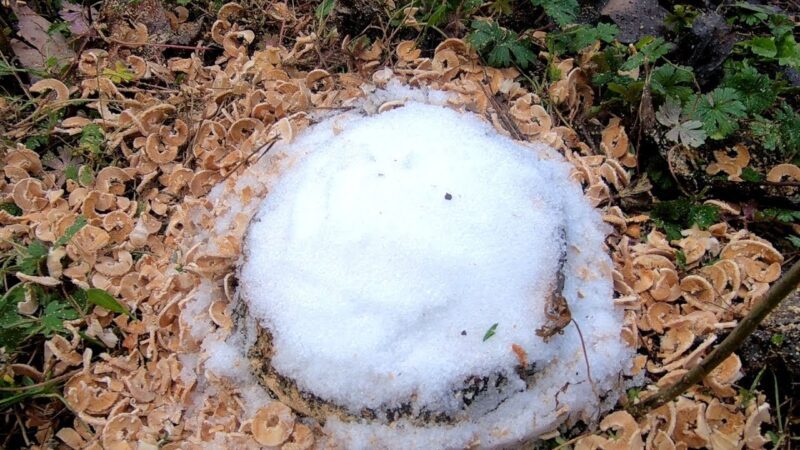
Many people don’t like chemicals and prefer Epsom salt to stump remover products. However, while Epsom salt speeds up natural decay, it will take much longer than stump remover chemicals.
Step 1: Drill holes in the tree stump, following the above-mentioned method.
Step 2: Saturate the entire area around the stump.
Step 3: Pour Epsom salt into the holes. You can also spread the salt around the base of the stump.
Step 4: Add water to the holes to fill them, but don’t allow the Epsom salt to spill out. Alternatively, you can mix a 2:1 Epsom salt to water solution to pour into the holes.
Step 5: Cover the stump with a tarp to keep rain from washing away the Epsom salt. Allow the salt to work for the next few months, then repeat this process. It will take about 6-12 months for the stump to decay before it’s soft enough to remove with an ax.
How To Kill a Tree Stump With Rock Salt
Rock salt speeds up the natural decay process by promoting the growth of fungi. You can use the same method described for Epsom salt, but cover the stump with soil and mulch after you add the salt. Water it every few days for about two months to keep it moist.
You can add potassium nitrate fertilizer to the rock salt to encourage fungal growth. Keep the stump covered for at least two months before disturbing it, as fungal growth requires humidity, warm temperatures, and nutrients.
How To Kill a Tree Stump With a Tarp
Using a tarp or a plastic bag is another way to kill a tree stump. It is the easiest method available but much slower than any other technique.
To kill a tree stump with a tarp, use a chainsaw to cut it as low to the ground as you can. Then, cover it with a tarp or plastic weighed down with rocks or bricks. If you have small stumps, you can use a dark bucket to cover them.
How To Kill a Tree Stump With Boiling Water
Boiling water is a common organic method for killing weeds and works on tree stumps. Like other methods that don’t use harsh chemicals, it will take longer for the stump to rot, but the roots will quickly die and stop sending up sprouts.
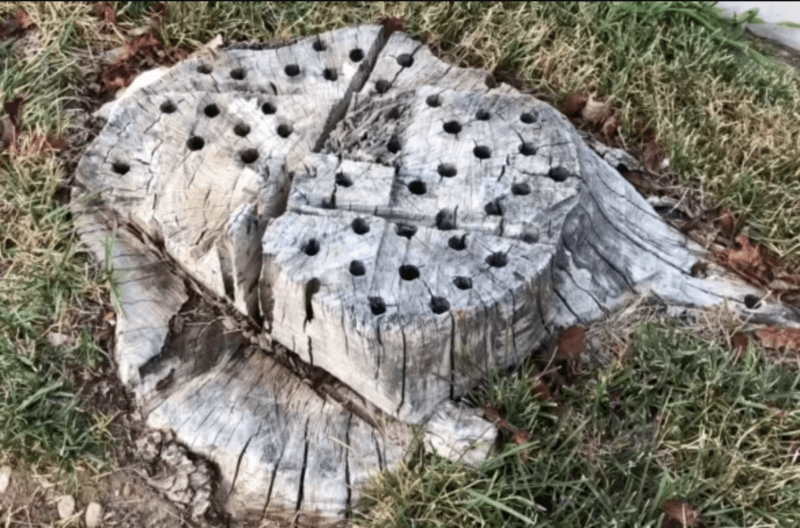
To kill a tree stump with boiling water, clear the soil to expose the roots as much as possible so you can drill holes into them. Drill vertical holes in the top of the stump and the roots, then pour boiling water into them.
You may need to repeat the process a few times to kill the stump completely, but the decay process can only begin once it’s dead. After it’s dead, you can cover the stump with soil and mulch to promote natural decay.
How To Remove a Tree Stump By Hand (Without a Grinder)
Knowing how to take care of your lawn involves more than just mowing. Besides basic lawn care, your yard maintenance chores may extend to removing stumps by hand.
Digging out a stump can be tedious and labor-intensive, but it is an effective way to keep stumps from growing back.
Even though removing a tree stump by hand is time and labor-intensive, it’s still much faster than using chemicals. So if you have more time than money, you can use one of these DIY stump removal techniques to get rid of your stump quickly.
Tools Required
- Chainsaw
- Ax
- Pulaski
- Clippers
- Handsaw
- Safety glasses
- Work gloves
- Rake
Materials Required
- Kerosene
- Kindling
Fire
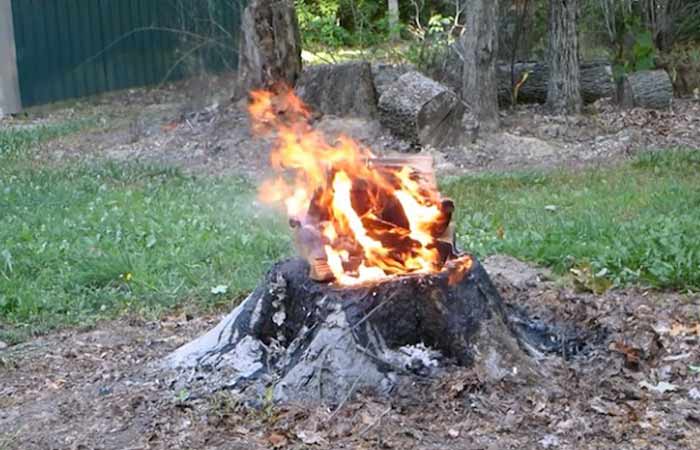
Tips for using fire to remove a stump:
- Using fire to get rid of a stump will kill the tree completely and allow you to plant a lawn or flower bed over the area. However, it won’t remove all of the roots.
- Do not use this method if you live in a dry climate that is susceptible to wildfires.
- Burning often requires a fire permit, so contact your local fire department or lands department before burning.
- Use kerosene in small amounts, as it is toxic and can kill surrounding animals and plants.
- Don’t use gasoline or diesel fuel. These burn off quickly, are ineffective, and are toxic to animals and plants.
- Never throw fuel on a burning fire.
Follow these steps to burn the stump:
Step 1: Clear the area around the stump, fully exposing the mineral soil.
Step 2: Use the chainsaw to cut the stump down as far as possible. Cut crisscross lines into the top of the stump about six inches deep. Always wear safety gear when using a chainsaw.
Step 3: Pour kerosene on the stump, and allow it to soak into the lines you cut with your chainsaw. You can also drill deep holes into the stump and pour kerosene into them.
Step 4: Use kindling to start a fire on top of the stump and continue burning until it has burnt below ground level.
Digging
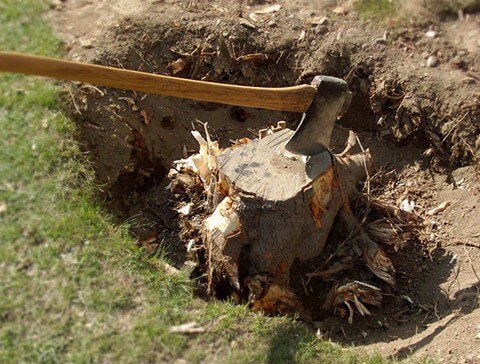
Digging a tree stump out of the ground is a lot of work and requires destroying a large area of your yard, but it is a quick and effective way to remove a stump and its roots.
Step 1: Start digging a few feet from the stump. Go around the perimeter and work toward the center, cutting roots with a handsaw, chainsaw, ax, or pulaski . Use clippers or loppers on smaller roots.
Step 2: Many trees have a large tap root, and you must continue digging until you can sever it. If you’re removing a large stump, you will have a big hole and must be careful when cutting the roots at the bottom of the stump.
Step 3: Use a winch or chain to pull the stump from the ground. Dispose of the stump and roots.
Step 4: Fill the hole back in, add dirt, and cover the area with topsoil.
How To Remove a Tree Stump With a Grinder
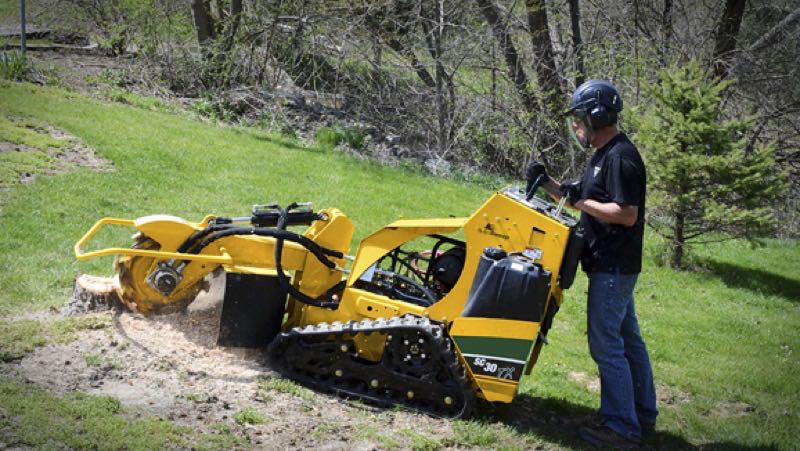
The fastest way to remove a tree stump is with a grinder, but it can be expensive; and it requires physical strength to operate a stump grinder. Rental costs are usually between $50 to $150 for half a day, so you should prepare the area before renting the equipment.
Professional stump grinders use heavy-duty hydraulic equipment that makes quick work of stumps. They charge between $140 to $450 per stump, so it might be cheaper to use a professional if you need to remove several stumps.
Gather your tools, and follow the steps below if you plan on renting a stump grinder and doing it yourself.
Tools Required
- Long-sleeved shirt and pants
- Chainsaw safety pants
- Safety glasses
- Hearing protection
- Work boots
- Work gloves
- Hard hat
- Shovel
- Rake
Step 1: Prepare the area by digging around the tree stump and removing rocks. Use a chainsaw to cut the stump as low as possible and dig a furrow around the entire stump.
Step 2: After you prepare the area, rent the grinder. Roll it up to the stump and adjust the handlebars to waist height. Set the brake and hold the handlebars down to lift the blade off the ground before you start the grinder.
Step 3: Start the machine, and use the lever to move the grinding head across the stump in a slow, rolling motion.
Step 4: When you’ve removed about six inches, stop the machine, then roll it forward and reset the brake. Continue using the blade to chip away at the stump and grind it to about six to ten inches below ground level. If you’re planning on building over the stump, remove an amount equal to the diameter of the stump.
Caution Tips
Use these caution tips when using a stump grinder:
- Stump grinders are heavy equipment and can be dangerous. Always wear protective clothing and gear, keep long hair up, and don’t wear dangling jewelry.
- Hitting a rock can ruin the teeth on the grinder, so be careful to remove all rocks.
- Flying rocks and debris are dangerous, so keep pets and children away. Also, do not allow bystanders to stand close to the equipment.
- Stay away from the cutter wheel.
- Let the machine’s weight fall on the stump to apply force to the cutting head. Never press on the handlebars to force the machine to grind faster.
- Always keep the brake on when using the grinder, so it doesn’t kick back.
- Hold the handlebars with an open grip with your thumbs on the bar. This way, they are less likely to get hurt if the machine kicks back.
- Take your time. You can grind small stumps in about 15 minutes, but large stumps may take up to 2 hours.
- Start your project early in the day to avoid operating the stump grinder at night.
How To Remove a Large Tree Stump
Removing a large tree stump from your yard can be challenging, but there are a few effective methods. You can dig it out, burn it out, or use a stump grinder.
For large stumps, hiring a professional stump removal service is recommended.
How To Remove a Small Tree Stump
You can remove a small tree stump using any of the described methods. Depending on how fast you want to get rid of a stump, you can choose from chemical and organic stump removal methods.
If you need to remove it quickly, use a stump grinder or dig it out.
How To Remove a Palm Tree Stump
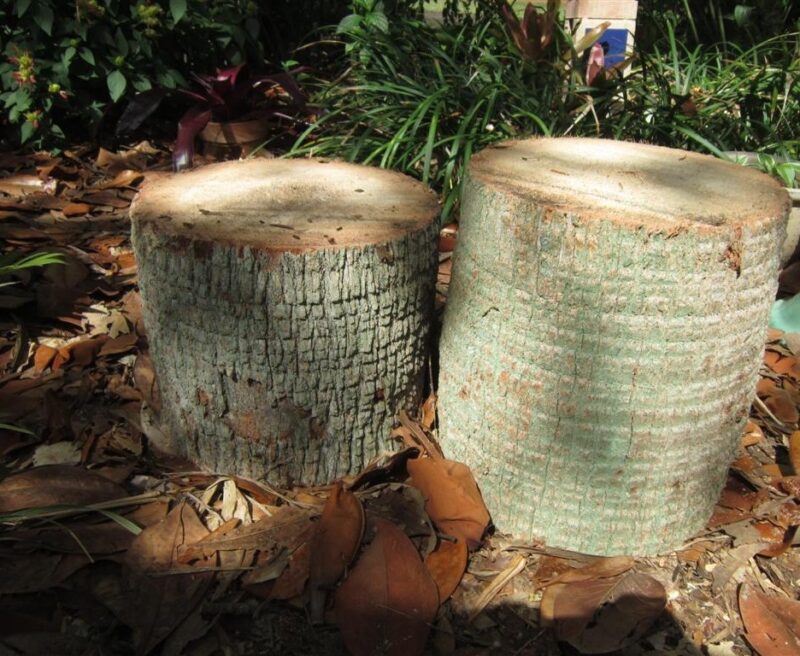
Palm tree stumps are challenging to remove because their long, stringy roots intertwine, making it difficult to cut them. Even though they don’t have a tap root, the tangled web of roots that spread out from the stump can make it tough to dig, so the easiest way to remove a palm tree stump is by using a stump grinder.
Getting Rid of the Tree Roots
Unless you dig out your stump, you could still have tree roots left behind after you remove a stump. Eventually, the roots will decay, but if exposed, they can be an obstacle when mowing. They also create tripping hazards and may be unsightly.
To get rid of tree roots after stump removal, use one of these methods:
First, dig them out: Grinding your stump to at least eight inches below the ground will make it much easier to dig out the roots.
Chemicals: Drill holes in the roots and use stump remover chemicals. These harsh chemicals can endanger children, pets, small animals, and surrounding plants, so take appropriate caution.
Epsom salt: Drill holes in the roots and use Epsom salt to speed up decay. This method requires more patience, and you must apply the Epsom salt several times.
Patch the Stump Area
After you remove a stump, it’s time to celebrate. But before you get carried away in the revelry, patch the stump area to prepare it for planting.
Following basic lawn care tips can result in a lush and healthy lawn.

You should remove large pieces of roots and debris, but you can fill the hole with the wood chips and dirt left behind. Backfill the hole, using extra fill dirt, and then top the area off with a mixture of compost and turf builder.
Use a spade to turn over the top 6 to 8 inches, then rake it smooth and plant grass seed to complete your project.
Once your grass is established, continue your regular grass care routine.
FAQs About Tree Stump Removal
What’s the Best Time to Remove a Stump?
The best time to remove a stump is right after the tree is felled. However, you can remove a tree stump whenever you’re ready.
Basic lawn care is more difficult when you have stumps in your yard, so removing them as soon as possible is best.
Can I Leave a Tree Stump in the Ground?
Tree stumps are obstacles that you have to mow around, and no matter how many creative ways you find to decorate a stump, they aren’t attractive. You can leave a tree stump in the ground, but you’ll have to deal with suckering roots and fungal growth.
On the other hand, you’ll feel a sense of relief once it’s removed, and it will create more usable space in your yard.
How Long Does It Take a Stump to Rot Away on Its Own?
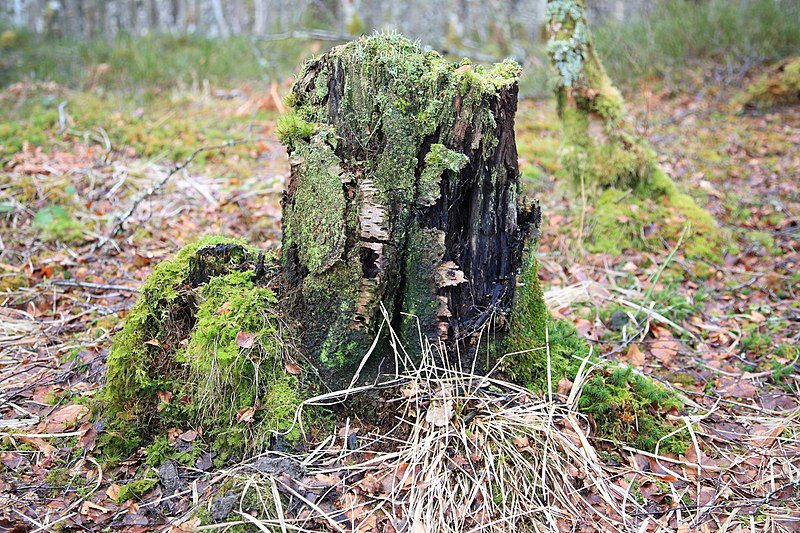
Several factors are involved in how long it takes for a stump to rot without chemicals. The size and species of the tree are critical factors, as some types of wood are resistant to decay. For example, a large oak stump might take up to twenty years to rot.
Other factors that affect how fast a tree rots include moisture levels, insect activity, fungal growth, and sunlight. Wood rots more quickly in moist environments, so a stump in a shady area will decay much faster than one in the sun.
How Far Down Should You Grind a Stump?
If you wish to plant a new tree in the same area, it is recommended that you have the stump completely removed. Professional stump removal services usually grind stumps to a depth of four to six inches, but some can go as deep as 16 inches. If you just want to grow grass in the area, grinding the stump four to six inches below ground level is sufficient.
If I Grind the Stump, Do I Need to Remove the Roots?
The best course of action is to grind the stump deep enough to make it easy to remove the roots. Of course, you don’t have to remove the roots when you grind the stump, but roots close to the surface can interfere with plant growth. They can also be tripping hazards and mowing obstacles when they stick up above ground level.

